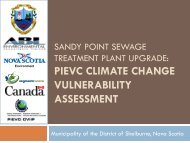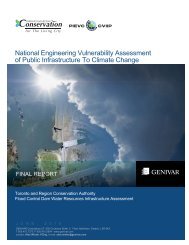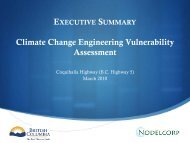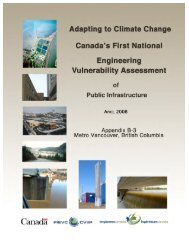EXECUTIVE SUMMARY - Vulnerability Committee
EXECUTIVE SUMMARY - Vulnerability Committee
EXECUTIVE SUMMARY - Vulnerability Committee
Create successful ePaper yourself
Turn your PDF publications into a flip-book with our unique Google optimized e-Paper software.
VULNERABILITY OF VANCOUVER SEWERAGE AREA INFRASTRUCTURE TO CLIMATE CHANGEFINAL REPORTMETRO VANCOUVER MARCH 2008According to Ouranos, climate scenarios are difficult to produce for certain highlylocalized events (wind gusts, tornadoes, and thunderstorms) or events where processesare complex and depend on a number of factors (hurricanes, ice storms). Therefore,quantitative predictions of wind speed were not provided.As described in more detail in Section 2, there are a number of uncertainties andassumptions involved in the climate projections listed above and these reflect onlylimited possible future scenarios for GHG emissions. In addition, regional climate isaffected by large-scale oscillations known as: El Niño/Southern Oscillation (ENSO); and Pacific Decadal Oscillation (PDO).ENSO is a well-known phenomenon characterized by an east-west shifting pattern intropical sea surface temperatures. The time scale of the shifts is relatively short: cycleslast from 2 to 7 years. Generally, El Niño winters are associated with decreasedprecipitation in southwestern British Columbia. The reverse trend occurs during La Niñaevents.The PDO operates over the entire Pacific basin on a decadal timescale. Phases maypersist for about 20 years to 35 years. The PDO shifted to a warm phase in 1976. Forcoastal B.C., the warm phase generally results in thinner snowpacks due to highertemperatures and generally a greater percentage of precipitation in the form of rain. Aconsensus has not yet been reached on whether the PDO has shifted to a cool phase.VANCOUVER SEWERAGE AREA (VSA)The VSA is largely a combined sewer system. Combined sewers are an older type ofcollection system that carry both wastewater and stormwater in the same pipe. Combinedsewers were less expensive to install and maintain when they were built, generally priorto the 1960’s. During heavy rainfall, combined sewers can overflow directly into anearby waterway such as the Fraser River or Vancouver Harbour, producing a CSO. Thisoverflow provides a “safety valve” that prevents back-ups of untreated wastewater intohomes and businesses, flooding in city streets, or bursting underground pipes.Metro Vancouver’s plan is to reduce, then eliminate, CSOs through the process ofgradual conversion to a separated sewer system. Metro Vancouver has committed toelimination of CSOs by 2050 in the 2002 Liquid Waste Management Plan (LWMP). TheLWMP also commits Metro Vancouver to upgrade Iona Island Wastewater TreatmentPlant (IIWWTP) to full secondary treatment no later than 2020. This pilot study istimely, as a planned revision of the LWMP is currently underway.The VSA is served by the IIWWTP, the second largest wastewater treatment plant inMetro Vancouver. The design peak wet-weather flow (PWWF) of the IIWWTP is 17KERR WOOD LEIDAL ASSOCIATES LTD.ASSOCIATED ENGINEERING (B.C.) LTD.251.219iii








